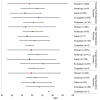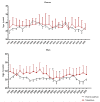No Trends in the Age of Peak Performance among the Best Half-Marathoners and Marathoners in the World between 1997-2020
- PMID: 33922718
- PMCID: PMC8146545
- DOI: 10.3390/medicina57050409
No Trends in the Age of Peak Performance among the Best Half-Marathoners and Marathoners in the World between 1997-2020
Abstract
Background and Objectives: We examined the possible trend in the age of peak performance in elite endurance athletes according to sex, continent of athletes' national citizenship, and ranking position. Since performance is a multifactorial trait, this information can be used to guide the long-term training and to plan the strategies related to the selection process of athletes. Materials and methods: Information of 1852 professional athletes, classified as top 20 performance of each year in marathon and half-marathon events between 1997 and 2020 were considered. Analysis of variance was computed to test differences in age between sex, continent, and rank position. Results: A significant difference between groups in the mean age of peak performance was observed (F (3, 1884) = 42,31; p < 0.001). For both sexes, half-marathoners were younger than marathoners (male, 25.6 ± 3.6 years vs. 28.0 ± 3.9 years; female, 27.5 ± 4.4 years vs. 28.4 ± 4.1). Female half-marathoners in 2004 presented the highest mean age (31.1 ± 4.8 years) compared to their peers in the years 1997, 2001, 2018 and 2019; among male half-marathoners, those in 1999 presented the highest mean age when compared to 2011, 2018, and 2019. Differences between the continents of athletes' national citizenship were observed (F (4, 1884) = 62,85,601; p < 0,001). Asian runners presented the lowest mean age (26.5 ± 3.7 years), while their European peers presented the highest (31.1 ± 3.9 years). No significant interaction between sex and ranking position was verified. Differences were observed between sexes for categories "4th-10th positions" and "11th-20th" (F (1, 1879) = 23,114; p < 0.001). Conclusions: Over the last two decades, no clear trend was observed in the changes in the age of peak performance among endurance athletes of both sexes, but, in general, female half-marathoners tended to be significantly older than their male peers.
Keywords: age peak performance; athletes; running.
Conflict of interest statement
The authors declare no conflict of interest.
Figures



Similar articles
-
Marathon Specialization in Elites: A Head Start for Africans.Int J Sports Physiol Perform. 2018 Jan 1;13(1):102-106. doi: 10.1123/ijspp.2017-0069. Epub 2018 Jan 19. Int J Sports Physiol Perform. 2018. PMID: 28488940
-
Performance and age of African and non-African runners in half- and full marathons held in Switzerland, 2000-2010.Open Access J Sports Med. 2013 Jul 24;4:183-92. doi: 10.2147/OAJSM.S45918. eCollection 2013. Open Access J Sports Med. 2013. PMID: 24379724 Free PMC article.
-
Half-marathoners are younger and slower than marathoners.Springerplus. 2016 Jan 26;5:76. doi: 10.1186/s40064-016-1704-9. eCollection 2016. Springerplus. 2016. PMID: 26844023 Free PMC article.
-
Ultramarathon runners: nature or nurture?Int J Sports Physiol Perform. 2012 Dec;7(4):310-2. doi: 10.1123/ijspp.7.4.310. Int J Sports Physiol Perform. 2012. PMID: 23197583 Review.
-
An evaluation of the training determinants of marathon performance: A meta-analysis with meta-regression.J Sci Med Sport. 2020 Feb;23(2):182-188. doi: 10.1016/j.jsams.2019.09.013. Epub 2019 Oct 18. J Sci Med Sport. 2020. PMID: 31704026
Cited by
-
The frequency and performance trends of European countries in the U18 and U20 rankings for 1500 m and 3000 m between 2009-2020.Sports Med Health Sci. 2023 Feb 7;5(3):213-219. doi: 10.1016/j.smhs.2023.01.003. eCollection 2023 Sep. Sports Med Health Sci. 2023. PMID: 37753421 Free PMC article.
-
Differences in race history by distance of recreational endurance runners from The NURMI Study (Step 2).Sci Rep. 2023 Oct 23;13(1):18083. doi: 10.1038/s41598-023-45055-w. Sci Rep. 2023. PMID: 37872366 Free PMC article.
-
Is there stability in the performance of elite half-marathoners?Sports Med Health Sci. 2022 Mar 4;4(2):101-104. doi: 10.1016/j.smhs.2022.02.003. eCollection 2022 Jun. Sports Med Health Sci. 2022. PMID: 35782280 Free PMC article.
-
Ultramarathon Evaluation above 180 km in relation to Peak Age and Performance.Biomed Res Int. 2022 Aug 26;2022:1036775. doi: 10.1155/2022/1036775. eCollection 2022. Biomed Res Int. 2022. PMID: 37284504 Free PMC article.
-
Running Pace Percentile Values for Brazilian Non-Professional Road Runners.Healthcare (Basel). 2021 Jun 30;9(7):829. doi: 10.3390/healthcare9070829. Healthcare (Basel). 2021. PMID: 34209293 Free PMC article.
References
-
- Berthelot G., Len S., Hellard P., Tafflet M., Guillaume M., Vollmer J.-C., Gager B., Quinquis L., Marc A., Toussaint J.-F. Exponential growth combined with exponential decline explains lifetime performance evolution in individual and human species. AGE. 2011;34:1001–1009. doi: 10.1007/s11357-011-9274-9. - DOI - PMC - PubMed
MeSH terms
LinkOut - more resources
Full Text Sources

